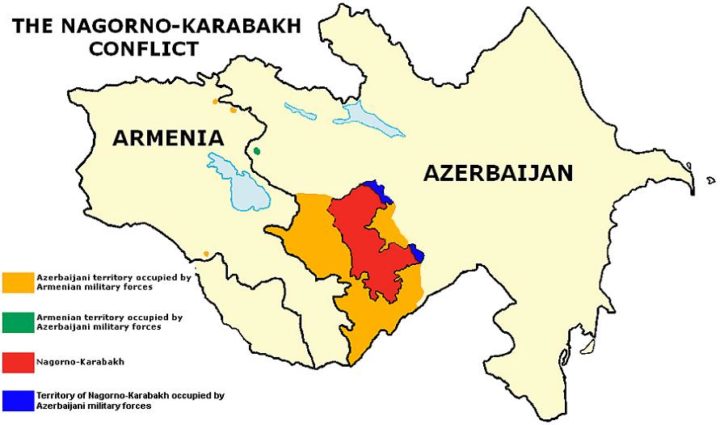27 September 2020 marked the start of a renewed armed conflict in Nagorno-Karabakh among the forces of Azerbaijan, the Armenian-populated Republic of Artsakh, and Armenia. The conflict has provoked a loss of life and the destruction of civilian property. Of the 150,000 persons living in the Republic of Artsakh prior to the start of the fighting, a large percentage of women and children have fled to Armenia. There is a real danger of further escalation with unforeseen consequences and a danger of the involvement of other States in this South Caucasus conflict. Thus 27 October marked the start of the second month of war.
The earlier 1992-1994 conflict which led to the creation of the Armenian-populated Republic of Artsakh within what had been the Soviet republic of Azerbaijan was related to the breakup of the Soviet Union and the end of the ethnic-based republics or autonomous zones which had been largely put into place in 1922 by Stalin, then Commissioner for Nationalities[i].
In order to halt the 1992-1994 war during which some 500,000 persons were displaced, the Organization for Security and Cooperation in Europe (OSCE) created an 11-State committee for mediation called the Minsk Group, with France, the USA and Russia as co-chairs. The Minsk Group has organized a number of mediation meetings, but these meetings have led to no modification to the broad structures of the situation nor to any real cooperation between Azerbaijan and Armenia. The Minsk Group was increasingly seen in the Caucasus as ineffectual. Frustration with the lack of progress was strongest among the leaders of Azerbaijan who have been arguing since 1994 that their territorial integrity is being violated by Armenia. The Armenian reply is that Nagorno-Karabakh has a majority of Armenian people and that they have a right to self-determination. In the current conflict, each of the co-chairs has tried to organize a ceasefire, but no ceasefire has held.
For the co-chairs of the Minsk Group, there are other preoccupations. The USA is involved in the last stages of a campaign for president at a time of domestic unrest. France is preoccupied with conflicts in the Sahel States of Africa where it has soldiers involved as well as with domestic issues of health and terrorism. Russia does not want to be seen to support Armenia more than Azerbaijan as it has good economic relations with both. Russia also has domestic concerns which limit its influence in foreign conflicts.
What is different today from the 1992-1994 war is the direct involvement of Turkey on the Azerbaijan side. Azerbaijan is using a large number of Turkish-made drones and has a monopoly of air space. It is likely that Turkey has also supplied specialists in the use of drones. In addition Turkey has facilitated the arrival of Turkish-backed militias and mercenaries from Syria. While many of the mercenaries are poorly trained, they add to the Azerbaijan fire power without having to use Turkish soldiers.
Also in the current conflict, Azerbaijan has the support of Iran which it did not have in 1992. There is a considerable Azeri minority in Iran pushing for active support of Azerbaijan. For the moment, Iranian support is only verbal but may be important if the issue of Nagorno-Karabakh is taken up within the United Nations.
This armed conflict has a potential to create even greater tensions within an already tension-filled area. Mediation with the aim of creating negotiations in good faith is a vital need. Confidence-building measures between Azerbaijan, the Republic of Artsakh and Armenia are needed. There is a need for a series of steps which go beyond a ceasefire. It will not be easy to get agreement among the parties as to what could constitute confidence-building measures but a series of steps are necessary preconditions for peacebuilding.
[i] For a good analysis of Stalin’s nationality policies, see Helene Carrere d’Encausse The Great Challenge: Nationalities and the Bolshevik State 1917-1930 (New York: Holmes and Meier, 1992)






